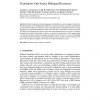Free Online Productivity Tools
i2Speak
i2Symbol
i2OCR
iTex2Img
iWeb2Print
iWeb2Shot
i2Type
iPdf2Split
iPdf2Merge
i2Bopomofo
i2Arabic
i2Style
i2Image
i2PDF
iLatex2Rtf
Sci2ools
MT
2002
2002
Translation with Scarce Bilingual Resources
Machine translation of human languages is a field almost as old as computers themselves. Recent approaches to this challenging problem aim at learning translation knowledge automatically (or semi-automatically) from online text corpora, especially human-translated documents. For some language pairs, substantial translation resources exist, and these corpus-based systems can perform well. But for most language pairs, data is scarce, and current techniques do not work well. To examine the gap between human and machine translators, we created an experiment in which human beings were asked to translate an unknown language into English on the sole basis of a very small bilingual text. Participants performed quite well, and debriefings revealed a number of valuable strategies. We discuss these strategies and apply some of them to a statistical translation system. Key words: bilingual corpora, translation strategies
| Added | 22 Dec 2010 |
| Updated | 22 Dec 2010 |
| Type | Journal |
| Year | 2002 |
| Where | MT |
| Authors | Yaser Al-Onaizan, Ulrich Germann, Ulf Hermjakob, Kevin Knight, Philipp Koehn, Daniel Marcu, Kenji Yamada |
Comments (0)

